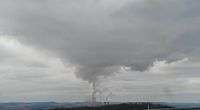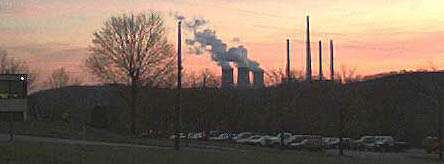Homer City Generating Station
| Homer City Generating Station | |
|---|---|
|
| |
 Location of Homer City Generating Station in Pennsylvania | |
| Country | United States |
| Location | Center Township, Indiana County, Pennsylvania |
| Coordinates | 40°30′39″N 79°11′37″W / 40.51083°N 79.19361°WCoordinates: 40°30′39″N 79°11′37″W / 40.51083°N 79.19361°W |
| Status | Active |
| Commission date | Units 1, 2: 1969; Unit 3 1977 |
| Owner(s) | General Electric |
| Thermal power station | |
| Primary fuel | Bituminous coal |
| Type | Steam |
| Feeding mines | Local Pennsylvania, or Western Pennsylvania Pittsburgh seam |
| Cooling source | Two Lick Reservoir, Two Lick Creek, and Blacklick Creek |
| Power generation | |
| Units operational | Steam turbine |
| Nameplate capacity | 2,022 MWe |
Homer City Generating Station is a 2-GW coal-burning power station near Homer City, in Indiana County, Pennsylvania, USA. It is majority-owned by General Electric and operated by NRG Energy. Units 1 and 2, rated at 660 MWe, were launched into operation in 1969. Unit 3, rated at 692 MWe nameplate capacity, was launched in 1977.[1] It employs about 260 people, and generates enough electricity to supply two million households.[2]
Location
The station is located in Center Township, Indiana County, Pennsylvania, occupying approximately 2,400 acres (9.7 km2). The site also includes the 1,800-acre (7.3 km2) Two Lick Reservoir, a water conservation facility which is operated by the station.[2]
Coal supply
As of 2005, bituminous coal was delivered to the Homer City Generating Station by truck. Units 1 and 2 burned local Pennsylvania coal (that is cleaned on site in a coal cleaning plant) or Western Pennsylvania Pittsburgh seam coal. But now with diminishing local coal and mines to support it, the train track that runs through Indiana University of Pennsylvania has reopened and now supplies are brought in by train. A flue-gas desulfurization unit (scrubber) was added to Unit 3 which allows the unit to burn local coal.[2]
History
Until its construction in the 1960s by the Pennsylvania Electric Co. (PenElec) and others, much of the property was owned by the Benamati family. In 1969, generating units #1 and #2 began operation, while unit #3 began operating in 1977.[2]
In 2001, affiliates of General Electric bought the plant from Edison, and subsequently leased it back to them. In 2011, Edison International failed to secure financing to add pollution-control devices and announced plans to transfer full control of the plant to General Electric. On February 29, 2012, Edison took a $1 billion impairment charge related to the Homer City plant and several other coal-fired power plants. At the end of 2012 full control of the plant was transferred back to General Electric, which hired an NRG affiliate to operate the plant.[3]
Water use
Boiler water make up, condenser cooling water, and potable water is taken from Two Lick Creek, processed through various pretreatment facilities, used and discharged through various environmental treatment facilities, and returned to Two Lick Creek and Blacklick Creek. From there, the Black Lick enters the Conemaugh River, which goes on to meet the Loyalhanna River, creating the Kiskiminetas River, before entering the Allegheny River.[2]
Pollution
A scrubber was added in 1998 which reduced mercury output. In 2012, General Electric, through contractors, began construction of anti-pollution control equipment known as "scrubbers" to further reduce the plant's emissions.
Sulfur dioxide (SO2) pollution
- In 1995, Homer City discharged 127,383 pounds (57.780 metric tons) of SO2.
- In 2003, Homer City discharged 151,262 pounds (68.611 metric tons) of SO2 and was ranked SO2 polluter #4 in the nation. The scrubbers that the plant is installing will make Homer City one of the nation's cleanest coal-fired power plants.
- In 2005, Homer City's rank was reduced to #6 as they discharged only 119,771 pounds (54.327 metric tons) of SO2 that year.[4]
Selenium in wastewater discharges
In 2007, the Pennsylvania Department of Environmental Protection (DEP) fined the owners of the Homer City electricity generating station, EME Homer City Generation LP, $200,000 for violating the Pennsylvania Clean Streams Law. The station exceeded its permitted effluent standards for selenium, total suspended solids, and biochemical oxygen demand in its wastewater discharges, and allowed discharges of stormwater associated with its flue-gas desulfurization scrubbers.[5]

Oxides of Nitrogen (NOx)
Homer City's three coal boilers installed Selective Catalytic Reduction to reduce ozone-forming NOx emissions in 2000 and 2001. This technology produced up to an 83% reduction in NOx emissions in subsequent years. Since the optimum years of 2005-06, emissions have begun to creep back up towards what they were before the installation of this technology. During the summer of 2012 plant emissions of NOx doubled over the 2005-06 period from 2,300 tons to 4,500 tons, even as electrical generation fell by 30%.[6] Through this same period, the price of natural gas, which competes with coal as a fuel for electrical generation, fell by some 60%.[7] Through the 2013 summer ozone season, this trend in rising emission rates continued resulting in over 6,300 tons of NOx emissions in excess of what could have been achieved had the plant operated at its previously demonstrated optimum rates seen in 2005-06.[6]
Architectural mention

The plant's Unit 3 has a 371 m (1,217 ft) tall chimney, which was built in 1977. This chimney is currently the third tallest chimney in the world, the second tallest in North America, and the tallest in the United States. On clear days, it is possible to spot the chimney from as far south as Greensburg, Pennsylvania and as far east as Ebensburg, Pennsylvania. The chimney is no longer in use, as the gas flow from Unit 3 has been bypassed through a newer flue gas treatment system installed in 2002.
See also
References
- ↑ "Existing Electric Generating Units in the United States, 2006" (Excel). Energy Information Administration, U.S. Department of Energy. 2006. Retrieved 2008-07-14.
- 1 2 3 4 5 "Homer City Generating Station" (PDF). Edison International. 2005. Retrieved 2008-08-02.
- ↑ "Town Hopes to Keep Tower of Coal Power". The Wall Street Journal. News Corp. 2012. Retrieved 2012-03-14.
- ↑ "10236-north-american-power-plant-emissions-en" (PDF). Retrieved October 15, 2016.
- ↑ "DEP fines Homer City generating station $200,000 for selenium discharges". Commonwealth of Pennsylvania. July 13, 2007. Retrieved 2008-08-02.
- 1 2 "Air Markets Program Data", USEPA, http://ampd.epa.gov/ampd/
- ↑ http://www.eia.gov/dnav/ng/hist/n9190us3m.htm
External links
- 2005 toxic output numbers
- Dirtiest Plants 2003
- Post Gazette article
- Environmental Working Group article Mercury Falling
- Pennsylvania plant rankings
- Public Citizen mention of pollution from Homer City power plant
- Survey of major mercury polluters in USA
- Mention of Homer City scrubber
- Diagram of Unit 3 - Skyscraper Page